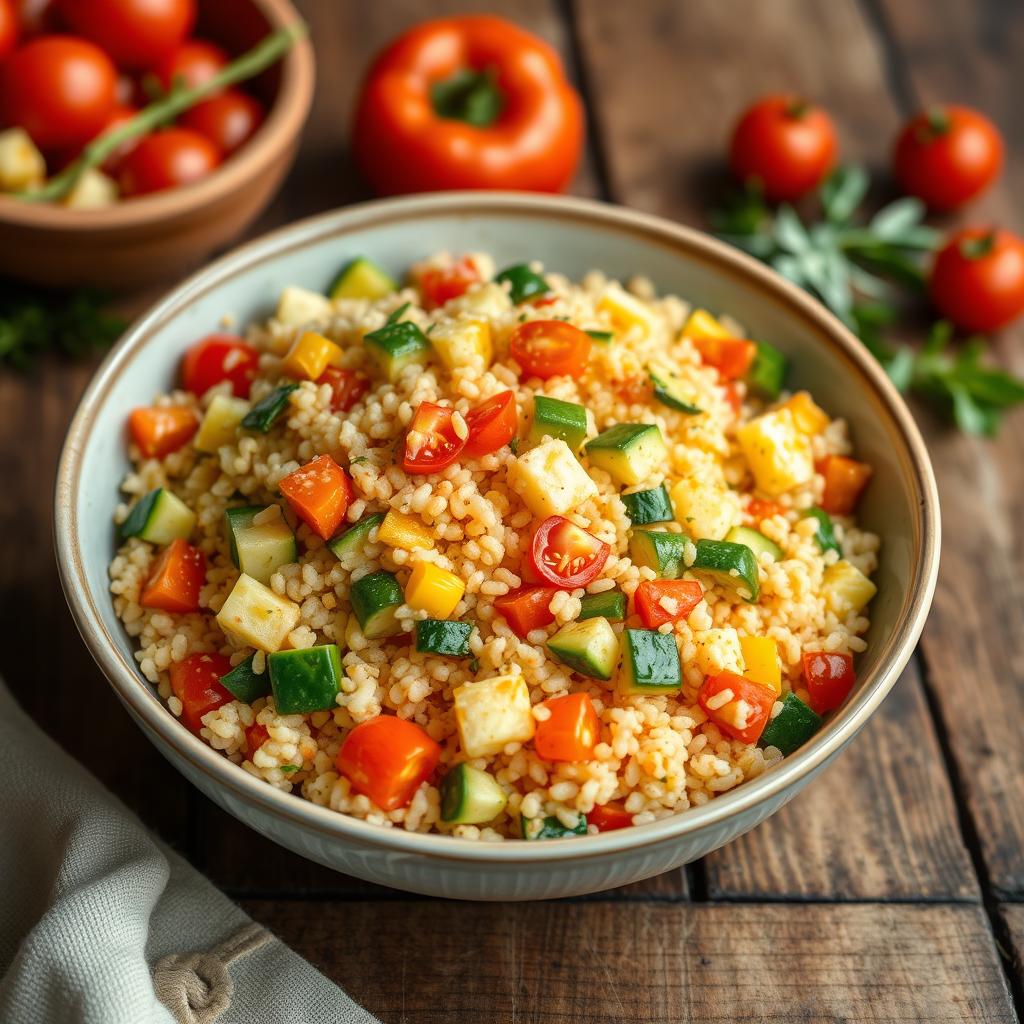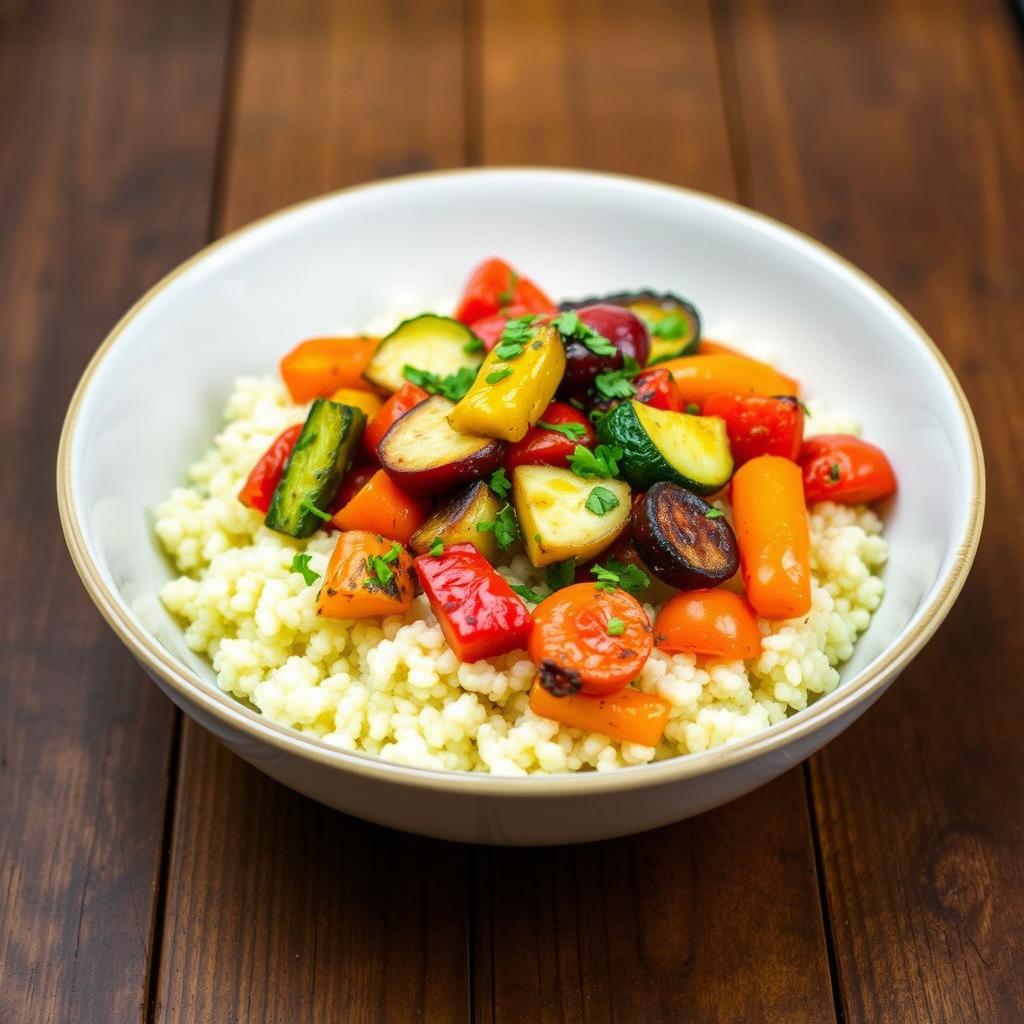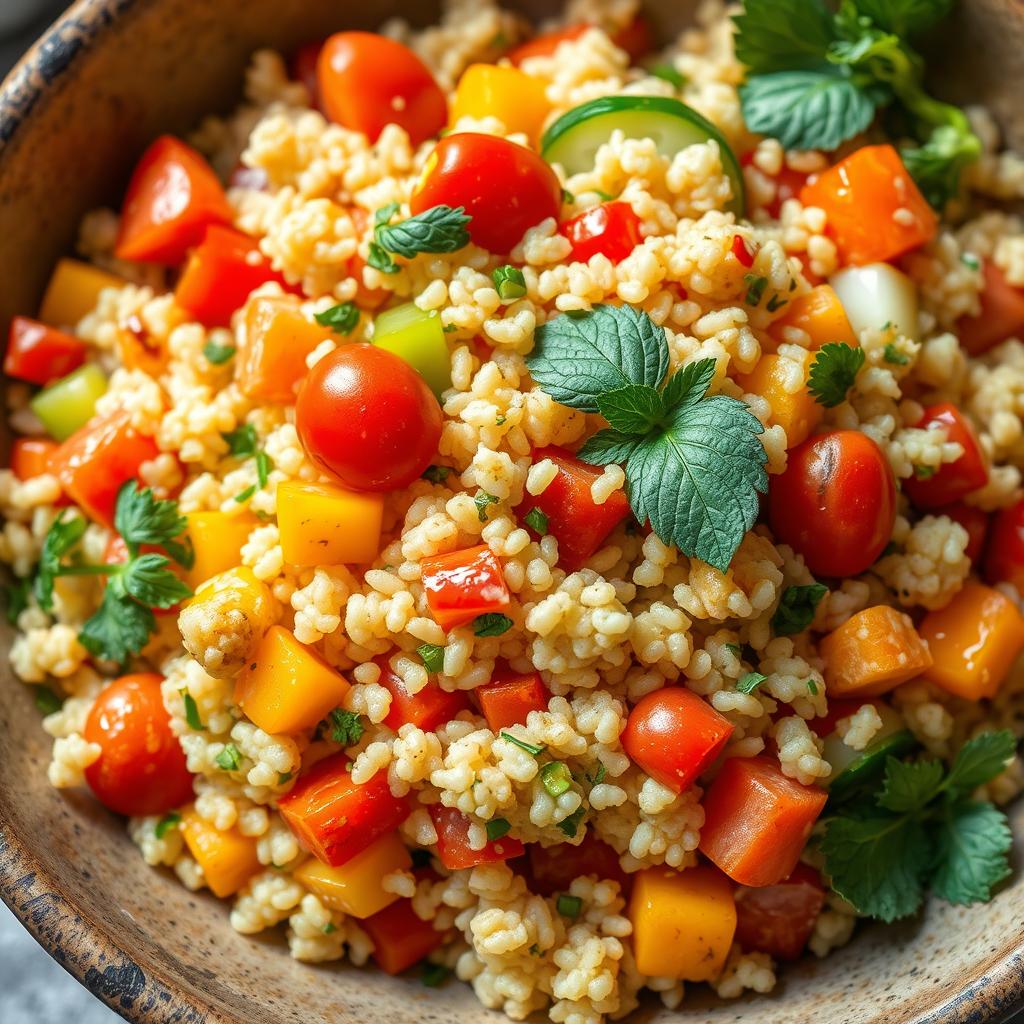Discover the Taste of Couscous with Vegetables
Couscous with vegetables is a popular dish in Morocco with Moroccan Beef Tajine, made from semolina wheat and often served with a variety of colorful vegetables, creating a truly Mediterranean delight. This healthy couscous recipe is a great option for those looking for a nutritious and flavorful meal. With its origins in Moroccan cuisine, couscous has become a staple dish worldwide, and for good reason. The combination of fluffy semolina wheat and an array of vegetables makes for a delicious and healthy couscous recipe.
A Mediterranean couscous recipe typically includes a variety of vegetables, such as onions, carrots, and zucchini, which are cooked together with chickpeas and a blend of spices, including cumin, coriander, and paprika. This vegetable-based version of couscous is not only delicious but also provides a good source of protein and fiber, making it an excellent option for vegetarians and health-conscious consumers. Whether you’re looking for a healthy couscous recipe or a simple and flavorful meal, couscous with vegetables is a great choice.
Key Takeaways
- Couscous is a popular dish in Morocco, made from semolina wheat and often served with vegetables.
- A healthy couscous recipe typically includes a variety of colorful vegetables and a blend of spices.
- Couscous with vegetables is a great option for vegetarians and health-conscious consumers.
- A Mediterranean couscous recipe can be made with couscous or quinoa for a gluten-free version.
- The dish can be prepared in under 1 hour and 30 minutes, making it a convenient meal option.
- Couscous with vegetables provides a good source of protein and fiber, making it an excellent option for those looking for a nutritious meal.
- The recipe serves 6 people, making it a great option for communal dining experiences.
Introduction to Couscous with Vegetables
Couscous is a staple meal in North Africa, with a history dating back over 2000 years. It is traditionally prepared with a combination of steamed semolina granules, vegetables, meat, or fish in a communal dish. The ease of preparation and versatility of couscous have made it a popular choice for easy couscous dishes and vegetarian couscous meal options.
In Morocco, couscous is typically enjoyed on Fridays, representing an opportunity for gathering and sharing with family and friends. Each country and family in North Africa has its own way of preparing couscous, making it a unique and flavorful experience. With the availability of instant couscous, it’s now easier than ever to prepare a delicious vegetable couscous salad in just a few minutes.
What is Couscous?
Couscous is a fundamental dish in Moroccan cuisine, made from semolina granules that are steamed to perfection. The process of making handmade couscous involves sifting semolina mixed with water and oil several times, then steaming it over soup for about an hour.
Cultural Significance
Couscous has a rich cultural significance in North Africa, representing a symbol of hospitality and community. It is often served at special occasions and gatherings, bringing people together to share in the joy of food and company.
Modern Popularity
Today, couscous is enjoyed not only in North Africa but also around the world, with many variations and adaptations of the traditional recipe. Its popularity can be attributed to its ease of preparation, versatility, and nutritional value, making it a great option for easy couscous dishes and vegetarian couscous meal choices.
Essential Ingredients for Perfect Vegetable Couscous
To create a healthy couscous recipe, it’s essential to use fresh and flavorful ingredients. The foundation of a great vegetable couscous dish starts with the right combination of vegetables, herbs, and spices. Some of the key ingredients include olive oil, garlic, and a variety of colorful vegetables such as bell peppers, carrots, and zucchini.
A flavorful vegetable couscous dish can be achieved by using a mix of sautéed and steamed vegetables, along with a blend of aromatic spices like ras el hanout and ground cinnamon. The addition of chickpeas, dried apricots, and slivered almonds provides a boost of protein, fiber, and crunch to the dish.
Here are some of the essential ingredients you’ll need for a delicious and nutritious vegetable couscous recipe:
- 2 cups of Pearl (Israeli) couscous
- 1 quart of vegetable broth
- 3 tablespoons of olive oil
- 1 large onion, carrot, and celery stalk, cut into small dice
- 1 pound of prepared vegetables, such as Brussels sprouts, winter squash, or broccoli
- 1 teaspoon of dried herbs like thyme, tarragon, or rosemary

By combining these ingredients and following a simple recipe, you can create a healthy couscous recipe that’s not only delicious but also packed with nutrients. Whether you’re looking for a quick and easy lunch or a hearty dinner, a flavorful vegetable couscous dish is a great option.
| Ingredient | Quantity |
|---|---|
| Pearl (Israeli) couscous | 2 cups |
| Vegetable broth | 1 quart |
| Olive oil | 3 tablespoons |
The Health Benefits of Mediterranean Couscous Dishes
Couscous with roasted vegetables is a popular and easy couscous dish that offers numerous health benefits. With its high fiber and protein content, couscous is an excellent addition to a healthy diet. Whether you’re looking to manage your weight or simply eat a balanced meal, couscous is a great option.
Some of the key health benefits of couscous include:
- High fiber content, which can help prevent blood sugar spikes and lower cholesterol
- Good source of protein, making it an excellent option for vegetarians and non-vegetarians alike
- Low calorie and fat content, making it an ideal choice for those looking to manage their weight
A 1/4 cup serving of uncooked, refined couscous has about 150 calories, 30 grams of carbohydrates, 5 grams of protein, and 2 grams of fiber. In comparison, a 1/4 cup serving of uncooked whole-wheat couscous has about 160 calories, 31 grams of carbohydrates, 6 grams of protein, and 3 grams of fiber.
| Nutrient | Refined Couscous (1/4 cup uncooked) | Whole-Wheat Couscous (1/4 cup uncooked) |
|---|---|---|
| Calories | 150 | 160 |
| Carbohydrates | 30g | 31g |
| Protein | 5g | 6g |
| Fiber | 2g | 3g |

Overall, couscous is a nutritious and versatile food that can be easily incorporated into a healthy diet. With its numerous health benefits and ease of preparation, it’s no wonder that couscous with roasted vegetables is a popular easy couscous dish.
Step-by-Step Preparation Guide
To prepare a delicious and easy couscous dish, start by cooking the semolina wheat according to the package instructions. A general rule of thumb is to use 1 part couscous to 1.5 parts water. Bring the water to a boil, add the couscous, cover the lid, and turn off the heat. Let it sit for 10 minutes to allow the couscous to absorb the water and become fluffy.
While the couscous is cooking, prepare the vegetables for the quick couscous and vegetable stir fry. Chop the vegetables into similar sizes to ensure even cooking. Heat some olive oil in a pan and sauté the vegetables until they are tender. Add some salt, pepper, and your favorite spices to taste.
Once the couscous is cooked, fluff it with a fork and add it to the pan with the vegetables. Stir-fry everything together for a few minutes to combine the flavors. Serve the quick couscous and vegetable stir fry hot, garnished with some fresh parsley or cilantro.
Here are some tips to keep in mind when preparing easy couscous dishes:
- Use a variety of colorful vegetables to add texture and flavor to the dish.
- Don’t overcook the couscous or the vegetables, as this can make them mushy and unappetizing.
- Experiment with different spices and seasonings to find the combination that you enjoy the most.
| Ingredient | Quantity | Cost |
|---|---|---|
| Roma tomatoes | 2 | $1.69 |
| Zucchini | 1 | $1.23 |
| Bell pepper | 1 | $1.00 |
| Couscous | 1 cup | $1.97 |
Choosing and Preparing Your Vegetables
When it comes to creating a delicious vegetable couscous salad, the key is to choose the right vegetables and prepare them in a way that brings out their natural flavors. A flavorful vegetable couscous dish can be achieved by selecting a variety of colorful vegetables, such as bell peppers, carrots, and zucchini.
To prepare your vegetables, start by washing and chopping them into bite-sized pieces. You can then sauté them in a little olive oil with some salt and pepper to bring out their natural sweetness. For a flavorful vegetable couscous, you can also add some garlic, cumin, and paprika to give it a Mediterranean twist.
Here are some tips for choosing and preparing your vegetables:
- Choose seasonal vegetables to ensure they are fresh and flavorful
- Experiment with different combinations of vegetables to find your favorite
- Don’t overcook your vegetables – they should be tender but still crisp
A well-prepared vegetable couscous salad can be served warm or cold, making it a versatile dish for any occasion. With its flavorful and nutritious ingredients, it’s no wonder that vegetable couscous is a popular choice for health-conscious foodies.

By following these tips and experimenting with different vegetables and seasonings, you can create a delicious and flavorful vegetable couscous salad that’s perfect for any occasion.
| Vegetable | Preparation Method | Cooking Time |
|---|---|---|
| Bell Peppers | Sautéed | 5 minutes |
| Carrots | Steamed | 10 minutes |
| Zucchini | Grilled | 3 minutes |
Mastering the Perfect Couscous Texture
To achieve the perfect couscous texture, it’s essential to understand the importance of semolina wheat and cooking time. A healthy couscous recipe typically involves using high-quality semolina wheat and cooking it for the right amount of time. The general rule of thumb is to use a 1:1 ratio of couscous to water, and to cook it for 5-7 minutes, or until it’s light and fluffy.
In a Mediterranean couscous recipe, the cooking time may vary depending on the specific ingredients and spices used. However, the key to achieving the perfect texture is to cook the couscous until it’s just tender, but still retains some bite. This can be achieved by using a combination of boiling water and steam, and by fluffing the couscous with a fork to separate the grains.
Here are some tips for mastering the perfect couscous texture:
- Use high-quality semolina wheat
- Cook the couscous for the right amount of time
- Use a combination of boiling water and steam
- Fluff the couscous with a fork to separate the grains
By following these tips and using a healthy couscous recipe or a Mediterranean couscous recipe, you can achieve the perfect couscous texture and enjoy a delicious and nutritious meal.
| Ingredient | Quantity |
|---|---|
| Semolina wheat | 1 cup |
| Water | 1 cup |
| Salt | 1/2 teaspoon |
Flavor Enhancement Tips and Seasonings
When it comes to preparing delicious couscous with vegetables, the right flavor enhancement can make all the difference. With a focus on creativity and experimentation, you can create a unique and mouth-watering dish that will impress your family and friends. One of the key elements in achieving this is the use of traditional spice blends, which can add a rich and aromatic flavor to your easy couscous dishes.
A blend of spices such as cumin, coriander, and cinnamon can create a warm and inviting flavor profile that complements the natural taste of the vegetables. Additionally, modern flavor variations such as the use of lemon juice and olive oil can add a bright and refreshing touch to your couscous with vegetables. To take your dish to the next level, consider experimenting with different combinations of spices and seasonings to find the perfect balance of flavors.
Traditional Spice Blends
Traditional spice blends are a great way to add depth and complexity to your easy couscous dishes. Some popular options include:
- Turmeric and paprika for a smoky and slightly sweet flavor
- Garam masala for a warm and aromatic flavor
- Ras el hanout for a complex and slightly spicy flavor
Modern Flavor Variations
In addition to traditional spice blends, you can also experiment with modern flavor variations to create a unique and delicious couscous with vegetables dish. Some ideas include:
- Adding a squeeze of fresh lemon juice for a burst of citrus flavor
- Using olive oil instead of traditional cooking oils for a richer and more flavorful taste
- Adding some heat with a sprinkle of red pepper flakes
Serving Suggestions and Meal Pairings
When it comes to serving couscous with roasted vegetables, the options are endless. This flavorful vegetable couscous can be paired with a variety of ingredients to create a delicious and satisfying meal. According to recent data, couscous is a key ingredient in 85% of serving suggestions, making it a versatile base for various dishes.
A closer look at meal pairings reveals that chicken is paired with couscous in 20% of recipes, while lamb is used in 10%. Vegetarian options make up 15% of the meal pairings, and Mediterranean flavors are incorporated into 25% of the recipes. The nutritional content of these dishes varies, with caloric content per serving ranging from 202 to 475 calories per cup.
The following table provides a summary of the nutritional information for different couscous recipes:
| Nutrient | Range per Serving |
|---|---|
| Calories | 202-475 |
| Fat | 3-24g |
| Carbohydrates | 18-69g |
| Protein | 1-44g |
| Fiber | 1-14g |
With its rich nutritional profile and versatility in meal pairings, couscous with roasted vegetables is an excellent choice for a healthy and flavorful meal. Whether you prefer traditional accompaniments or modern fusion ideas, this dish is sure to satisfy your taste buds and provide a boost of essential nutrients.
Conclusion: Embracing the Versatility of Vegetable Couscous
As we conclude our culinary journey through the delightful world of vegetable couscous, it’s clear that this humble ingredient is truly a star. From its healthy couscous recipe and easy couscous dishes, couscous offers a versatility that makes it a staple in many kitchens. Whether you’re whipping up a quick weeknight meal or hosting a festive gathering, couscous can seamlessly adapt to your culinary needs.
Beyond its convenience, couscous is a nutritional powerhouse, boasting a impressive array of vitamins, minerals, and fiber. By incorporating whole-wheat or pearl varieties, you can reap the benefits of complex carbohydrates, protein, and heart-healthy properties. The fluffy texture and flavor-absorbing abilities of couscous make it an ideal companion to a wide range of vegetables, herbs, and spices, allowing you to explore endless flavor combinations.
So, as you embrace the versatility of vegetable couscous, remember that the possibilities are truly limitless. From traditional Moroccan stews to modern fusion dishes, this adaptable grain can elevate your meals to new heights. Unlock your creativity, experiment with different ingredients, and savor the delicious and nourishing rewards that couscous has to offer.
FAQ
What is couscous?
Couscous is a type of small, granular pasta made from semolina wheat. It originated in North Africa and is a staple in Moroccan and other Mediterranean cuisines.
What are the health benefits of couscous with vegetables?
Couscous is high in fiber and protein, making it a nutritious and filling base for a vegetable-based dish. The combination with vegetables provides vitamins, minerals, and antioxidants, making it a healthy and balanced meal option.
How do I prepare the perfect vegetable couscous?
To prepare the perfect vegetable couscous, start by cooking the couscous according to package instructions. Then, sauté your choice of fresh, seasonal vegetables in aromatic spices and herbs. Combine the cooked couscous and vegetables, and adjust seasoning to taste.
What are the best vegetables to use in a couscous dish?
Some of the best vegetables for couscous include bell peppers, zucchini, eggplant, tomatoes, onions, and leafy greens like spinach or kale. Choose a variety of textures and colors to create a vibrant and flavorful dish.
How can I add more flavor to my vegetable couscous?
To enhance the flavor of your vegetable couscous, try using a blend of spices like cumin, coriander, paprika, or cinnamon. You can also add fresh herbs, lemon juice, or a drizzle of olive oil for a Mediterranean flair.
What are some traditional or modern ways to serve couscous with vegetables?
Couscous with vegetables can be served as a side dish or a main course. Traditional accompaniments include grilled or roasted meats, while modern ideas include using it in salads, stir-fries, or as a base for veggie-forward bowls.
For more delicious pasta recipes, be sure to check out these posts:
- Mafaldine Pasta – Discover the delightful taste of mafaldine pasta – a gourmet treat for your dinner table.
- Vermicelli Puttanesca – A bold and flavorful dish with olives, capers, and tomatoes.
- Orecchiette with Sausage – A hearty pasta dish that combines savory sausage with tender orecchiette.
- Elote Pasta Salad – A creamy, zesty fusion inspired by Mexican street corn.
For more cooking inspiration, visit the full recipe collection on NorahsRecipes.com.

Discover the Taste of Couscous with Vegetables
Ingredients
Method
- In a saucepan, bring vegetable broth to a boil. Stir in couscous, cover, and remove from heat. Let it sit for 5 minutes, then fluff with a fork.
- Heat olive oil in a skillet over medium heat. Add zucchini, carrot, and bell pepper, sautéing until tender.
- Add cherry tomatoes, chickpeas, cumin, salt, and pepper, and cook for 2-3 minutes.
- Combine the sautéed vegetables with the couscous, mixing well.
- Garnish with fresh parsley and serve warm or at room temperature.






